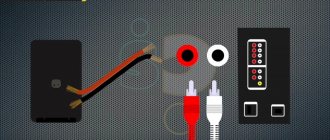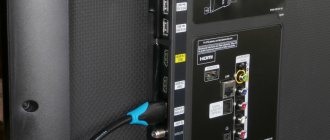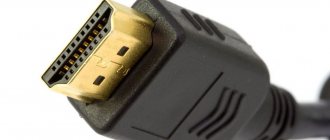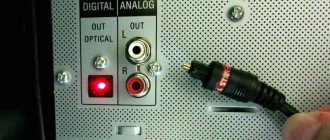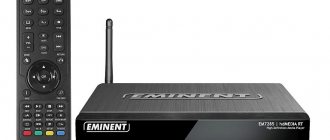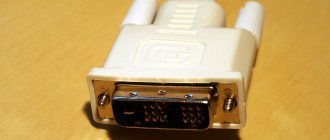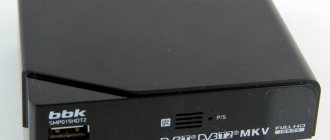HDMI (High-Definition Multimedia Interface)
Used for: connecting Blu-ray players, TVs, AV receivers, game consoles, personal computers and other high-frequency video devices. If you have a choice, choose this over an analog audio cable and a component video cable. This is similar to the performance and usage of the DVI digital video interface. Is an adapter for: DVI, Mini-DVI, Micro-DVI. Additional ports: connection to the receiver. In addition to carrying pure HD video at resolutions of 1080 pixels or more, HDMI can carry surround sound, including DTS and Dolby Digital. This digital cable fits most home theater slots, including TVs, receivers and game consoles. It supports HDCP encryption, so you can play copy-protected movies without any problems. This type of connection comes in several versions: standard HDMI 1.3 cable or high-speed 1.4 cable. The new version has additional bandwidth for viewing high-definition 3D video.
HDMI cable length and thickness
Surely many users are wondering what length of HDMI cable is best to purchase? According to regulatory documentation, the maximum wire length is 10 meters. There is no such information in the specifications, but often this parameter varies from 75 centimeters to 10 meters.
It is possible that you will be able to find a longer wire. However, it is absolutely not necessary to buy a cord, which is called “with a reserve”. Dimensions that do not comply with regulated standards may later become a catalyst for problems during operation. For example, attenuation or distortion will appear - all this will negatively affect the quality of the broadcast picture.
The quality of transmission depends not only on the size, but also on the material from which the cord is made. For testing, let's take the standard view of version 1.4. These cables are often constructed using 24 AWG oxygen-free copper. As for the High Speed type, it is created from a similar material, but the thickness is 4 AWG greater. This comparison clearly demonstrates that the quality of the material and its thickness directly affect the functionality and service life of the conductor.
It should be emphasized: if a standard cable is made of really high-quality material, then it will provide signal transmission up to 15 meters. If the length of the cord is more than 15 meters, and after connection the loss of picture quality is noticeable with the naked eye, then be sure to use special signal amplifiers.
The high-definition interface must convey absolutely all data to the receiver without any distortion. Many manufacturers note that wires made from expensive metals demonstrate the highest speed of information transfer with the complete absence of interference and failures.
It is worth considering that the use of expensive metals directly affects the cost of the wire. When choosing a cable accordingly, take into account the tasks you set for it. For example, to transfer data from a tuner or satellite receiver, a very ordinary cord will do, since the information flow is not large. Viewing 3D content will require more expensive models.
RCA (also known as composite video or phono plug)
Used for: basic settings, analog audio and video, sometimes digital audio. If you have a choice, choose this over coaxial cable. Is an adapter for: TRS “mini jack” (found on video cameras or MP3 players). Additional ports: splitter, repeater or receiver. RCA is introduced as a connector used throughout home audio and video equipment. For basic settings, you can use the white plug, as well as for mono audio or left channel, the yellow plug for video. The red plug usually means right-channel audio, but the connector can also carry other signals. Sometimes used in digital audio, in which a single cable carries the full surround audio signal. This cable is also suitable for component video.
Component video (also called RGB or Y-Pb-Pr)
Used for: HDTV video (especially on older TVs) and gaming systems. If you have a choice, choose it over composite RCA video, S-Video. This is similar to the performance and usage of a VGA cable (especially the RGB version). Is an adapter for: VGA if the device uses the RGB version. Additional ports: splitter, repeater or receiver. Component video signals are transmitted through three RCA cables, typically red, green, and blue. Component video operates at speeds up to 1800i, making it optimal for analog HDTV connections. Cables are usually designated Y/Pb/Pr, and indicate the level of brightness, blueness and redness. Some systems use different designations, often RGB meaning red, green and blue. There are devices that support both, but if you end up with an image that's completely green-toned, you've likely created the wrong color space.
Splitters and switches
Some adapters allow you to connect multiple cables at the same time. These devices function similar to an extension cord, routing multiple inputs into a single output cable. Others have the opposite effect and can split a single source across multiple cables. Many of these products may have a 1:4 ratio. Not all of these units are necessarily adapters. Some switches rely on one type of cable connection. This is especially useful for linking your TV to multiple devices that use RCA cables, such as DVD or Blu-ray players and game consoles.
Conclusion
Numerous video cables are manufactured for use with electronic devices.
Understanding which cables work with a specific device can help users optimize a product's performance and improve its compatibility with other devices. In many cases, devices may not be compatible due to changing input ports, especially between older and newer products. To solve these problems, there are a number of video cable adapters available for purchase. Adapters can be found in any combination to connect almost any two types of cables. To find the adapter you need, try typing keywords into a search engine to find an adapter that accommodates both types of cable.
S-Video (or Y/C)
Used for: mid-range video devices. If you have a choice, choose this over composite RGA and coaxial cable. It is an adapter for: composite video (but with loss of quality benefits). Additional ports: splitter, repeater or radio receiver. Although this type of connection expands on the composite RCA connection, S-Video still cannot be on par with cables that support HDTV.
Adapters
Adapters can be used to connect one type of video cable to another - they are effective connecting devices without which the two devices would be incompatible.
There are dozens of potential adapter combinations, and there are several ways to find these connections. If the buyer knows the specific types of cable and ports that he wants to combine, he can try to find such connections (adapters) online by typing the names of the two cables into the search box along with the word "adapter". For example, if a customer has an S-Video cable and wants to convert it to an HDMI cable, he or she can try typing "S Video to HDMI Adapter" into the search field.
Some shopping sites help simplify this process by defining names for each connector type. Keep in mind that the end of the cable connector is called male, while the port is called female, and therefore is often searched for "male-male" or "male-male".
Coaxial video (cable TV connection)
Used for: connecting antennas, conducting VRC for analog TV, connecting a cable broadcast source and a TV. This is analogous to the performance and use of composite video. Additional ports: splitter connections. Coaxial cable is used to transmit video and audio signals between devices. The cable is also suitable for a TV tuner antenna. Most cable companies use this type of conductor, although they primarily send a digital signal that is converted and decoded on your TV. You can almost always run a coaxial cable to your TV (with the exception of connecting a digital antenna), but you should expect only the basic quality features to work correctly.
Types of cables present on the Russian market
In addition to the standard plugs of such a gadget, on the shelves of electronics stores you can find their “younger brothers” - a mini USB/HDMI adapter and a mini HDMI/USB adapter. Similar USB/HDMI adapters are used for connecting to a TV or monitor of modern smartphones, tablet computers, and navigators.
HELPFUL INFORMATION!
Most older car recorders are equipped with mini-formats; modern gadgets use Micro USB/HDMI for charging and transmitting information. This is what a mini USB plug looks like - nothing to do with a micro one
Mini USB/HDMI adapter: an accessory that is gradually going out of use
The mini USB/HDMI converter is rarely used today, although it was the first such device. Today, “mini” has been replaced everywhere by “micro”, the transmission speed of which is much higher.
In fact, their characteristics are indistinguishable from ordinary USB ports. To make the micro USB/HDMI adapter work, you will need special drivers that are loaded into your smartphone, computer or laptop. Often drivers are included with the adapter, but even if they are missing, you can find the ones you need on the Internet. To do this, you just need to enter the device ID in the search bar.
GOOD TO KNOW!
Such switching makes it possible to transmit only images. If you need sound, you'll have to tinker with additional connections. It should be understood that such a connection is only possible if there is an HDMI jack on the monitor.
But what if you need to connect a tablet and a TV, provided that the TV is not equipped with such a port, but only has a USB socket? We'll figure out. This is the system for connecting a TV to a tablet or smartphone via an adapter
Micro and mini HDMI to USB adapters: what is the difference between the devices
Such devices are necessary when connecting a tablet or a modern digital camera to a TV that only has a USB connector. Initially, mini HDMI appeared. This was dictated by the fact that a regular port no longer fit on the body of gadgets that were becoming smaller and smaller. The same reason forced manufacturers to create a smaller plug - micro HDMI.
Nowadays HDMI/USB adapters are manufactured in various sizes (regular, mini, micro). Many people ignorant of microelectronics claim that micro HDMI transmits information more slowly than its “big brother”. They say that the contact area of the contacts is much smaller, which means that the micro cannot compete with a regular HDMI connector. However, this is a serious misconception.
The image transmission speed is no different - it is the same for all three types. You should not think that so many complexities are performed for the sake of viewing saved files. No, this is for a flash drive. An HDMI/USB adapter for a TV is capable of transmitting what is currently happening on the screen. You can turn on a movie on your gadget in OnLine mode and watch it on the big screen. When connected via an adapter, you can not only view recordings, but also watch what is happening on the gadget screen in real time
Toslink (also known as optical cable or S/PDIF)
Used for: gaming systems, connecting DVD players, cable boxes, and other radio devices. If you have a choice, choose this over analog RCA audio and other audio cables. This is similar to the performance and use of a single analog RCA audio cable. Is an adapter for: Mini Toslink. Additional ports: splitter and receiver. In digital connections, Toslink sends optical pulses that are decoded into audio. Typically an S/PDIF signal is used to provide surround sound details. (“S/PDIF” is sometimes used as a synonym for optical cable, although Toslink refers more to physical connectors). Mini-Toslink cables are sometimes used, especially with Apple computers, such connectors are often inside a standard 3.5mm stereo mini-jack port. The smart home system also uses such a cable in its connections.
How to connect a computer to a TV via Wi-Fi
Modern smart TVs can be connected to computers wirelessly via a local Wi-Fi network. Technologies like DLNA and Wi-Fi Direct allow you to broadcast video, music and other content to your TV screen or completely duplicate the image from your computer on your TV, turning the latter into a wireless monitor. Moreover, in the case of Wi-Fi Direct, you don’t even need a router for this.
For example, LG devices have a Smart Share service for similar functions. And Samsung TVs offer similar capabilities as part of the AllShare service.
Wireless connection settings may vary depending on the manufacturer and model of your TV. Some devices establish a connection in semi-automatic mode. Others require installation of additional software on the connected computer.
Therefore, it is difficult to formulate universal instructions that will suit all users. If you want to connect your TV to a computer via Wi-Fi, you will find the necessary information in the paper manual or on the manufacturer's official website along with the software required for this.
Mini-jack (TRS, 3.5mm jack, 1/8 inch jack, headphone jack)
Used for: portable audio devices, computers, portable speakers, video cameras. If you have a choice, choose this over a mono mini-jack. This is similar to the performance and use of a 1/4 inch jack, a 2.5mm jack. Is an adapter for: 2.5mm jack, RCA jack, 1/4 inch jack. Additional ports: splitter connection. This headphone jack is found in almost all audio devices, and is offered as the main jack on media players. You'll most often encounter stereo connections that have two rings on the end of the plug. If the plug has only one ring, then it will only conduct mono audio. The connector is also often used to carry video along with audio, converting a mini-jack to an RCA device. The audio signal on the minijack is louder than the stereo RCA signal, so if you are using an adapter (for example, connecting an iPod to the receiver), then increase the volume gradually.
Video cable types
Technology is constantly evolving, and electronics manufacturers must decide what types of input ports are relevant and optimal to include in their products. In many cases, a device may have multiple connections to increase its compatibility with older or different technology. Understanding the types of cables in an accessible form will help owners of various devices organize the connection of their equipment. The use of new cables can even improve the performance of the units. The following table lists the most common video cable types along with a description of each.
1/4 inch connector (TRS)
Used for: music equipment, headphones, professional equipment, home theater audio equipment. If you have a choice, choose this over a mono mini-jack. This is similar to the performance and use of a mini-jack, 2.5mm jack. Is an adapter for: mini-jack, 2.5mm jack, RCA jack. Additional ports: splitter connection. This jack most often carries stereo sound through headphones. It is also used on professional audio equipment, home theater audio components, and many other headphone-equipped devices.
2.5mm jack (also known as TRS)
Used for: mobile phone headset. If you have a choice, choose this instead of a mini-jack, a 1/4-inch jack. Is an adapter for: RCA connector, 1/4 inch connector, mini-jack. Additional ports: splitter. Although most mobile phones have a mini-jack connector, there are also many interfaces with a 2.5mm jack that support microphones or button locking. However, you can connect a fairly large headphone cable to this small jack and listen to music.
HDMI cable connectors
Previously, it was determined that the most progressive type is the High Speed with Ethernet cable in specification 1.4, and now we will talk about modifications to the connectors. Absolutely all types of HDMI are designated in Latin letters. Let's look at popular connectors:
- A – standard interface; this is the connector that manufacturers often equip digital equipment with. Suitable for connecting TVs.
- C (micro) and D (mini) – reduced HDMI connectors. Used to connect smartphones, cameras, laptops, tablets and other portable devices.
- B – the connector has an expanded video channel for broadcasting content with a resolution of more than 1080p. It is less popular than the previously listed types.
- E – equipped with a special lock that securely fixes the connector with the port when connecting the device. Used in cars when connecting audio systems.
How to choose the right connector? Consider the connection features, the size of the connector connector, as well as the goal that you set for yourself. For example, Type A is suitable for TVs, and C or D for smartphones.
XLR
Used for: mid to high end microphones. If you have a choice, choose this over the 1/4 inch connector. This is similar to the performance and use of a 1/4 inch jack. Is an adapter for: 1/4 inch jack (but this will not amplify the microphone). Additional ports: connection to a mixer. Although this connector can support a large number of pins, the three-pin version is most often used in midrange and professional audio equipment. Microphones also often use an XLR cable to amplify the sound.
Advantages and disadvantages of Type-C technology
Let's try to figure out what positive qualities TYPE-C has. The main ones are:
- secure connection. There is no need to be afraid that the plug will be placed the other way around and the socket will be damaged. Here it has a symmetrical shape, which allows it to be connected in both positions;
- versatility - it is compatible with all versions of USB;
- compactness is the main feature after speed. The port will not take up much space on the gadget's body.
What about the shortcomings? If we talk from a technical point of view, TYPE-C is ideal, there is nothing to attach to. The reason that the technology has not yet become widespread lies in the micro USB ports and plugs found on 90% of smartphones and tablets (the only exception is one of the “fruit” corporations). Few people today are ready to purchase additional adapters, despite the fact that the change in speed when connecting media to USB 3.0 will still not be noticeable. The new MacBook Air 12 Retina also has a TYPE-C connector
USB type-c cable
